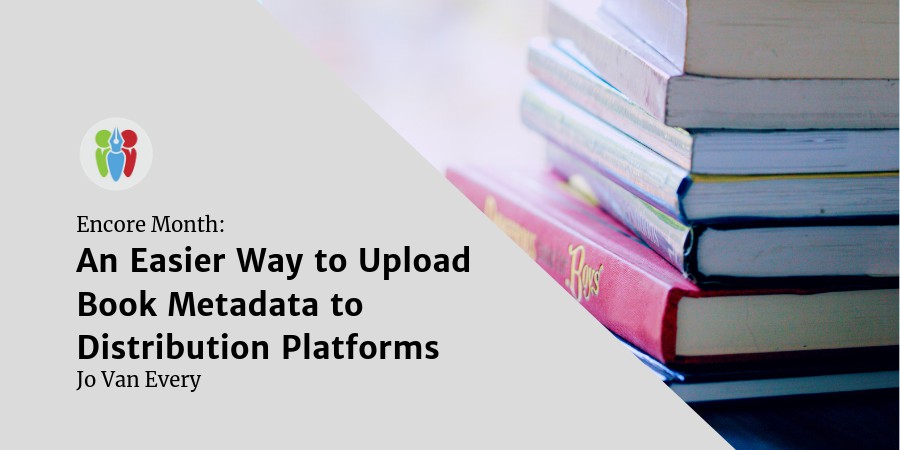
Jo Van Every shares her top tips for completely metadata on distribution platforms – and kindly shares her metadata template
An essential part of the indie author's self-publishing process is to complete the metadata on the distribution platforms of your choice. You might hire other professionals for some of the tasks involved in the process, but uploading the metadata is likely to rest with you, the publisher. In today's encore post, Jo Van Every explains how to upload book metadata like a professional.
You’ve read all the advice and figured out what platform(s) you will use to distribute your self-published book. But when you log in to the first distribution platform, you find yourself faced with a lot of drop down menus, text boxes, and possibly multiple pages of metadata information to enter before you can upload your files.
You might have to to find the information, some of which you didn’t know you’d need, and some of which is in a form you’ve never heard of before. (BISAC codes, anyone?) You’re not sure you’ve got enough time to do it all. You aren’t in the right frame of mind to draft text. AAARRRGGGHHH!!!
But there's an easy way to help you get through this challenge: create a metadata checklist and use a metadata template.
The Value of A Metadata Checklist
I have started creating checklists for things like this. I have much more important things to keep in my memory than all the details of this process.
Anything I have to do regularly but infrequently that has a lot of steps gets a checklist.
I have one for my bookkeeping, and I have them for the self-publishing process. Writing down the steps and sorting them into a logical order saves time and frustration. It also means I don’t have to worry about whether I forgot something important.
Creating a Metadata Template
In addition to a checklist of the process, I have created a metadata template for all the choices I need to make and text I need to have ready to copy and paste into the forms.
The first time I uploaded a file, I made a note of all the bits of information I needed to enter. I copied what I did enter into my file. I used that information to upload the book to another platform, added additional headings and notes, copied what I actually uploaded … Repeat and tweak.
Basically I channeled my frustration into something I could use to make the process less frustrating the next time.
After I got through that process the first time, I edited the file to make it more useful. I now have a template that I can copy and fill in before I log in to the various platforms I use to publish my books. I still have to make some tweaks once I’m in there, but it is a lot less frustrating. I also have a record of things like trim size and paper choice so I can make sure my print books have a consistent look and feel.
What is “metadata” Anyway?
Metadata is a fancy word for all the information that search engines look at when a reader is looking for a book. There are three categories of information:
- The Basics
- Title, Subtitle
- Series, volume in series
- ISBN (and/or ASIN, which Amazon will assign but you need to record)
- Imprint (if you have one)
- Length, trim size, illustrations, and other physical details
- Description (short & full)
- Price
- The Contributors: Author(s), Illustrator(s), etc
- Names
- Bio for each
- Prior work for each
- Affiliations (if any)
- Subjects, Keywords, and other things that aid discoverability
- BISAC subjects
- THEMA subjects
- Keywords
- Table of Contents
- Audience type
- Review quotes (if any)
Different platforms have slightly different length requirements and may use different subject categories. Drafting things in advance gives you something to edit. Brainstorming categories and keywords helps you figure out what to do with the options actually available. Deciding a price range gives you a place to start that you can adjust to get the options and royalty you want.
Your Very Own Publisher's Assistant Hat

Jo's metadata template serves as a virtual publisher's assistant's hat (Image by Clem Onojeghuo via Unsplash.com)
Using a metadata template and a checklist is like having a publisher’s assistant hat. You can assign yourself the task of asking Author-you for the details and then open up the first publishing platform equipped with most of the information you need to get your book uploaded. Update your checklist as you go, making notes of anything that went wrong and how you fixed it, so you have that information next time you have to wear this hat.
One of the important tasks of a good publisher’s assistant is to keep good records so make sure you copy your final decisions back to the file you’ve created for this book’s metadata. This makes it a lot easier to make sure that the information on your own website, on Goodreads, and anywhere else you put information about the book is consistent with what readers will see when they buy it. You could also record things like your universal book links and links to your book on various seller platforms to make them easier to find and share when you promote your book.
Help Yourself to My Free Metadata Template!
I’ve updated my template and made it public so you can see it, copy it, and adjust it for your own purposes.
Download Jo’s metadata template here.
OVER TO YOU Do you have any top tips to share that make any part of the self-publishing process easier? What tips and tricks do you use to upload book metadata? We'd love to hear about them!
#Indieauthors - like some help on uploading metadata to #selfpub book distribution platforms? Let @JoVanEvery - and her free template - help you out here! Share on XOTHER RELEVANT POSTS FROM THE ALLi AUTHOR ADVICE CENTER ARCHIVE
https://selfpublishingadvice.org/kdp-print-ingram-spark-paperbacks/






Taking this one (big) step further would be to enter the ONIX world, the way that trad publishers share metadata information with their partners.
This is probably a step too far for most indies, but that’s how it’s done for all your retailer partners who do NOT just let you upload metadata directly. More details here: https://hollowlands.com/2018/03/using-onix-as-an-independent-author/?utm_source=lk&utm_medium=cm-7
You say nothing about “Categories” and yet these are very important on Amazon–I wonder why not in your template. Otherwise, such a helpful thing to have and thank you for sharing it.